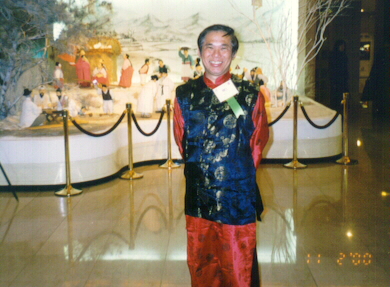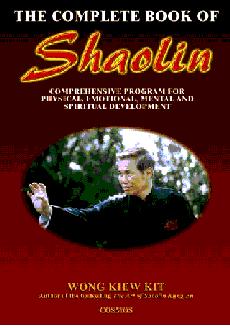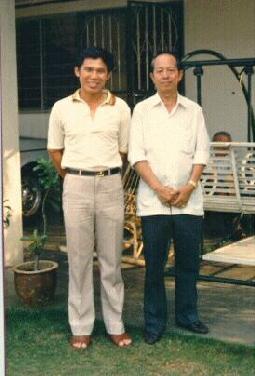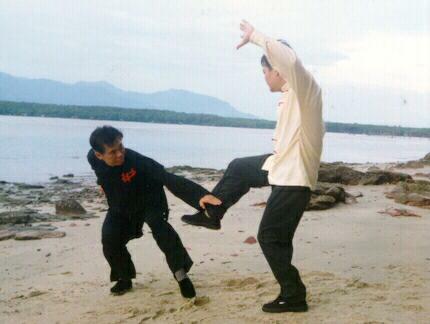GETTING THE BEST BENEFITS FROM YOUR TRAINING

Sifu Wong at the International Congress for the Unity of Science in Seoul in 2000
Five Steps to Maximum Results
Why can some people attain in six months what others may not attain in six years? This is not an exaggeration; indeed, many of my students have reported that they have benefitted in a few months what they could only read about in books but never experienced although they had previously practiced the art in question for many years. Chi kung and kungfu (including Taijiquan) provide some glaring, if not disturbing, examples.
It is not uncommon today to find practitioners who have been in chi kung or kungfu for many years, some of whom are even instructors themselves, but who have no experience whatsoever of energy flow or any ability of self defence. Yet, the very fundamental of chi kung is energy flow, and that of kungfu is self defence. It is even more disturbing when some people, irrespective of whether their intention is good or selfish, start to teach chi kung or Taijiquan, which is actually a very effective form of martial art, after they have learnt some chi kung or Taijiquan movements for a few weeks, some even for a few days!
If you learn from such self-taught "masters" you are not going to get good results even if you practice for a whole lifetime. On the other hand, if you learn form a genuine master, you will get better results in a much shorter time. Nevertheless, while learning from a genuine master, or at least a competent instructor, is important, there are other contributing factors too, and they are generalized into the following Five Steps to Deriving the Best Benefits from Your Training which can be found here:
- Have a sound knowledge of the philosophy, scope and depth of the art you practice.
- Define your aims and objectives clearly.
- Seek a master for the best available methods to attain your aims and objectives.
- Practice, practice and practice.
- Assess your progress or otherwise with direct reference to your set aims and objectivs.
Philosophy, Scope and Depth
Understanding the philosophy, scope and depth of your chosen art is the essential first step if you want good result. Such an understanding acts like a map; it not only shows you the way and how to get there, but also the potential result at the destination.
Without this understanding, many people not only waste a lot of time and are often lost along the way, but also they do not actually know what they are working at. If they understand, for example, that to practice chi kung or Taijiquan, actually means to work on energy flow or to train for combat efficiency, far less people would have wasted their time over exercises that at best are gymnastics or dance.
If they further understand that the scope and depth of chi kung are much more than just energy flow, though working on energy flow is its essential foundation; and that the scope and depth of great kungfu like Shaolin and Taijiquan are not just combat efficiency, though combat efficiency is the basic starting point, they would go beyond the foundation and basic to greater heights like vitality, longevity, mind expansion and spiritual fulfilment.
Where can you obtain knowledge on the philosophy, scope and depth of your chosen art? There are two main sources: living masters and established classics. Obviously if you hear it from a self-styled scholar who himself has not experienced what he says, or read it from a book which merely repeats cliches, you are unlikely to benefit much. Living masters were rare even in the past; they are rarer nowadays.
If you are so lucky to meet one, treat him with the respect as you would treat a living treasure. Showing Respect to the Master suggests the minimum you should do when meeting a living treasure. If you politely ask him relevant questions, he would answer them. If he gives excuses like the answers are too complicated for you to comprehend, or they involve secrets that you should not know (unless they really are secrets, which are not frequent in general questions), you are justified in suspecting whether he is a real master.
Established classics were also rare in the past, but they are more readily available today. You need to overcome two obstacles to understand the classics. One, you need to know classical Chinese; and two, you need to have some background knowledge. Most people, especially in the West, have neither of these two conditions. Their alternative is modern, easy-to-read books clearly written and well illustrated by practicing masters. Therefore, in chosing a book for your prior reading, you should decide on the following three factors: whether the book is dull or interesting, whether it is written in jargon or simple language, and whether the author and his material are authentic.
Defining Aims and Objectives

“The Complete Book of Shaolin” provides a comprehensive and in-depth understanding of the Shaolin arts
It is so evident that without aims and objectives much of the learning or training is usually unfruitful, that mentioning this fact may become trite. Yet, most people practice chi kung or kungfu without set aims and objectives! Try asking some practitioners why do they practice chi kung or kungfu, and many of them will start searching for their aims or objectives after, not before, they have heard your question. Even if they have prior aims and objectives, often they are merely fashionable slogans, rather than real definitions to remind them of the direction of their training.
For our puropose here, aims are general in their definition, and long-term in their attainment; whereas objectives are specific and short-term. For example, to be able to defend yourself is a general aim in your Taijiquan training, whereas to be able to release yourself from some particular locks and holds constitutes an objective. You should also set a time frame within which to accomplish your aims or objectives. Needless to say, you have to be realistic and reasonable when setting your time. For someone who has been suffering from an illness for years, for instance, it would be unreasonable to expect the disease to be overcome by just practicing certain chi kung exercises for only a few weeks.
For convenience, objectiuves may be classified into personal objectives and course objectives. The choice of personal objectives depends on the needs and abilities of the person in question, and sometimes on his whims and fancy. Developing the art of tiger-claw, and performing well the Five Animals kungfu set are examples of personal objectives in Shaolin Kungfu training.
Course objectives are related to the particular set of chi kung or kungfu exercises you intend to train for a period of time. For example, you may wish to spend six months on Golden Bridge training in Shaolin Kungfu, or on the Three Circles Stance in Taijiquan. In either case, developing powerful arms and solid stances is an appropriate course objective.
To define your aims and objectives wisely, it is necessary to have some sound knowledge of the philosophy, scope and depth of the art in question. For example, if you do not understand that chi kung also promotes mind expansion and spirutual circultivation, you will be in no position to touch on the mind and spirit while you define your aims and objectives. If you think (mistakenly) that Taijiquan is merely moving your body, arms and legs gracefully, the aims and objectives you set for your Taijiquan training, no matter for how long you may practice, are necessarily limited by your narrow perspective.
Seeking a Master for the Best Available Methods

Sifu Wong posting with his teacher, Sigong Ho Fatt Nam, many years ago
Having set your aims and objectives, the next logical step is to seek a master to help you realize your aims and objectives. Good masters are hard to find; you have to spend some time seeking them, but it is worth all your time and effort. The webpage Qualities of a Good Master will give you some ideas what to look for in your search. Remember it is you who seek the master; he may have neither the need nor the obligation to teach you. It is simply amazing why some people presume that just because they want to learn, a master is duty-bound to teach them. It is also illogical to presume that a master would not charge any fee for his teaching, that he could live on sunshine and water. The right attitude, which often turns out to be the best approach to a master, is for you to prove yourself to be a worthy student.
If you cannot find a master, at least look for a competent instructor, who must qualify in the following two conditions. One, he must be professional, i.e. he knows what he is teaching. Someone who teaches a profund art like chi kung or kungfu, after having learnt it for a few months, literally does not know what he is teaching. He does not know, for instance, that he is teaching chi kung-like or kungfu-like dance or gymnastics and not real chi kung or kungfu. The second condition is that he must be ethical, i.e. he ensures what he teaches is beneficial, and if his students develop adverse side-effects he knows about them and is capable of rectifying them.
A good master will choose the best available methods for you to acheive your aims and objectives. The selection will depend on numerous variables, such as your needs and abilities, the master's repertoire as well as enviromental factors and supportive resources. You may sometimes wonder if the choice made is a good one, but if he is a good master and has accepted you as his student, it is almsot always certain that he will choose the best method and procedure for you.
Alternatively, you may have known from your reading or elsewhere some useful methods to accomplish your aims and objectives. Your task, therefore, is to seek for a master who can teach you your selected methods. However, if he advises you to make any changes -- such as in your aims or objectives, your previously selected methods, or the procedure of training -- it is again almost always certain that with his wider perspective and experience, he knows your needs and how to fulfill them better than you do. It is not without justification for the saying that real masters are worth more than their weight in gold.
Practice, Practice and Practice
The fourth step is the most important and takes the most time. It is significant to note that this step is "practice, practice and practice", and not "learn, learn and learn". In fact, frequently in chi kung and kungfu, especially at this stage, the more you learn the less you accomplish! This does not mean that learning is detrimental; in fact, learning about the philosophy, scope and depth of chi kung or kungfu is the first essential step to obtaining the best result in your training. But if your training is geared towards chi kung or kungfu proficiency, it is detrimental merely to learn, learn and learn.
There are some crucial differences between practicing and learning. Practicing is practical and experiential; learning is theoretical and intellectual. Practicing deals with what has been known; its purpose is to develop and consolidate skills, force or ability. Learning deals with what is to be known; its purpose is to obtain new knowledge.
Masters are made through practice, scholars through learning. Masters perform, and directly experience what they profess. Chi kung or kungfu masters, for example, can demonstrate internal force, and experience vitality and mental freshness. Scholars merely talk, but often have no direct experience of what they know. Nowadays there are many chi kung and kungfu scholars, especially in the West, but there are very few masters, even in the East.
If you want to become a master, or just to be proficient, in chi kung or kungfu, you simply cannot escape this long process of practice, practice and practice. You do not practice just three times, or for three months, but preferably at least for three years. There is a saying that "three years of practice will bring a small success; ten years a big success". What you practice may be simple, and usually consists of only one or a few techniques!
Actually it does not really matter what you practice, so long as you practice, practice and practice long enough, you will become a master of what you practice -- even if your chosen method is inferior. If you continuously strike your palms onto a sand bag, or strike your leg against a coconut tree every day for three years -- methods which are considered "inferior" in our Shaolin Wahnam School of Chi Kung and Kungfu -- you will become a master of iron palm or iron leg, and may have the power to kill a person with just one strike. Unless you are particularly fond of showing off your brute strength, breaking bricks or someone's bones with your palm or leg, it is normally not a rewarding thing to do. Hence, if you have acquired a good philosophical background in your first step, you will be in a better position to choose a "superior" method to practice in this fourth step for more rewarding results.
Assessing Progress According to Aims and Objectives

Combat Application of Shaolin Kungfu
You should access your progress, or otherwise, according to your set amis and objectives. You must, of course, follow your master's advice and the conditions required by the method of training. If your master asks you to breathe slowly and gently, it is sheer folly to attempt to be smarter than the teacher by breathing fast or forcefully. If the method requires you to practice daily for six months, it is a waste of your time and your teacher's effort if you discontinue your training after three weeks because you have not experienced any effect.
If you follow your master's advice and practice according to the requirements of the established method, you will obtain the results that method is reputed to give. For example, Self-Manifested Chi Movement is reputed to clear energy blockage and balance energy level, and the pattern Grasping Sparrow's Tail in Yang Style Taijiquan is reputed to be an effective counter against all modes of attack. If you have practiced them correctly and adequately, you will have your energy blockage cleared, and be able to defend against all attacks. Why is this so? It is because the methods are established, which means they have been time tested for centuries to produce the expected results.
If you do not derive the expected results, which may sometimes happen, the fault is usually traceable to one or more of the following three causes:
- the practice is incorrect or insufficient
- the teacher is incompetent
- the student is inadequate
Rectify the fault and the expected results will follow as a matter of course.
Your assessment is made not only at the completion of the training but also regularly during the course itself. Of course modifications, but not complete changes, are made when necessary, but they should be done with the master's approval and supervision.
These Five Steps to Maximun Results may enable you not only to obtain remarkable results in shorter time, but also to approach the full potential your training can offer. For example, students who do not have the benefit of these five steps may be quite contented in their chi kung or kungfu training once they can cure their illness or attain combat efficiency, thinking that is all what chi kung and kungfu can do. Others who follow the five steps will understand a wider scope and greater depth of their art, and will therefore in a position to derive other benefits like mental clarity and spiritual joy.
The Five Steps show not only the procedure to follow but also the relevant dimensions to cover, involving all the three essentials in any training, namely the method, the teacher and the student. Hence, with this understanding one can appreciate that to get the best results in any training, be it chi kung, Taijiquan, Shaolin Kungfu, playing the paino or painting, merely having good techniques is not enough, he (or she) must also have a good teacher and himself be a good student. With such advantages and foresight, it is not surprising you can achieve in six months what others may not be able to do so in six years.
